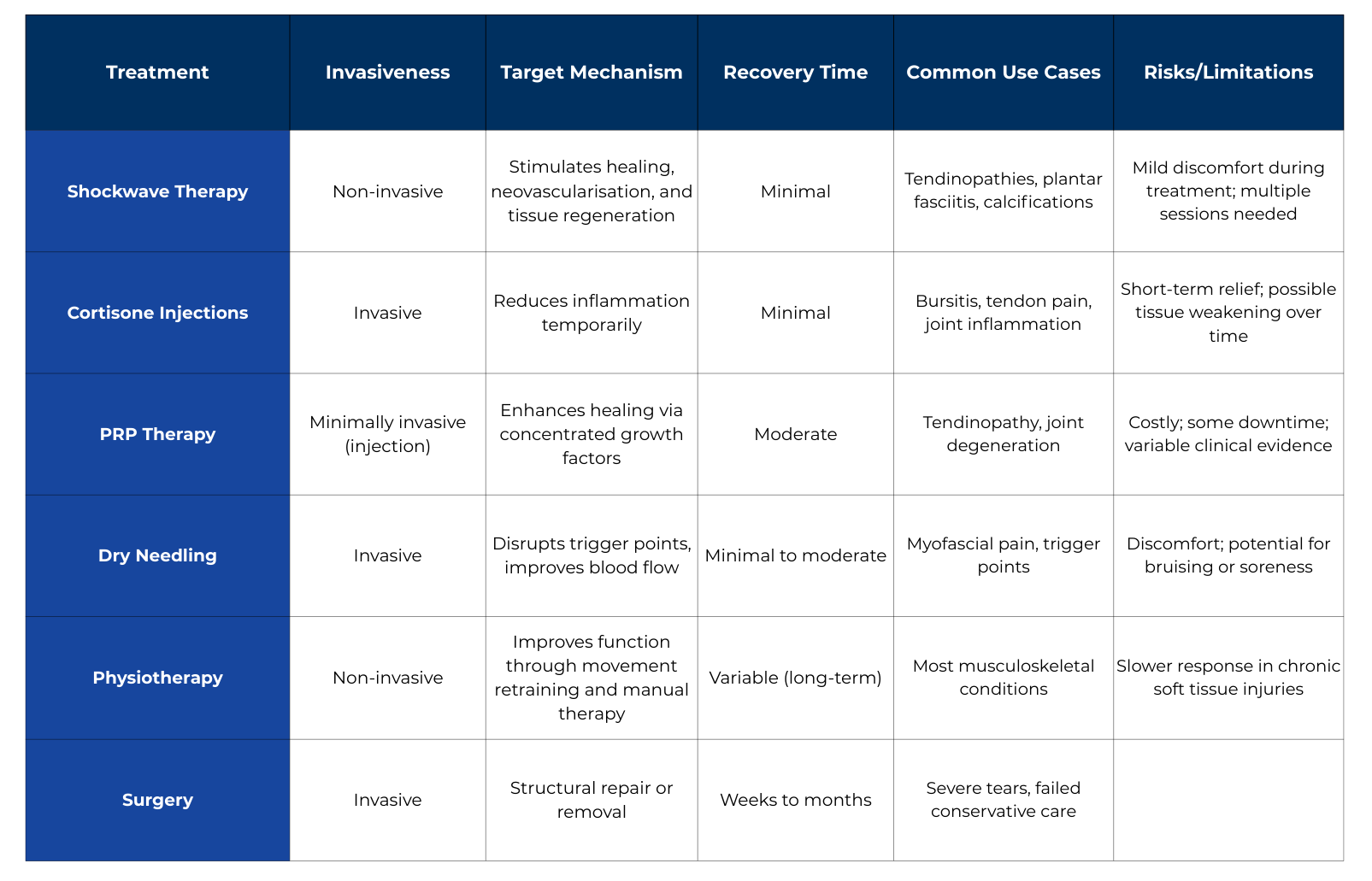Introduction
When it comes to managing chronic pain or soft tissue injuries, there are several treatment options available, from cortisone injections and platelet-rich plasma (PRP) to physiotherapy and surgery. But how does shockwave therapy measure up against these alternatives? At Tensegrity Sports Clinics, we offer radial shockwave therapy (rESWT) as part of our comprehensive treatment approach, and it’s proven to be a powerful non-invasive alternative in musculoskeletal care.
In this post, we’ll compare shockwave therapy to other popular treatment options — helping you understand the key differences and determining which therapy might be the best fit for your needs.
Shockwave Therapy vs Cortisone Injections
Cortisone Injections: Cortisone injections are a common treatment for inflammation-related pain, often used in cases like tennis elbow, shoulder tendinopathy, and plantar fasciitis. They work by reducing inflammation and providing short-term relief, but they don’t address the underlying cause of the pain.
Shockwave Therapy: In contrast, shockwave therapy doesn’t just mask the pain. It works by stimulating tissue regeneration, improving blood flow, and enhancing collagen production. Shockwave therapy can help the body heal damaged tissues, which makes it a better long-term solution for chronic conditions.
Comparison:
Cortisone: Quick pain relief, but the effects are short-lived. It can also weaken tendon tissue with repeated use.
Shockwave: Provides long-lasting relief by promoting healing at the tissue level, reducing the need for repeated treatments.
Study Insight: Rompe et al. (2001) found that shockwave therapy showed superior results at 12 months in comparison to cortisone for lateral epicondylitis.
Shockwave Therapy vs Platelet-Rich Plasma (PRP)
PRP Therapy: PRP therapy uses a patient’s own blood, which is processed to concentrate the platelets and growth factors that promote healing. It’s commonly used for tendinopathies and joint injuries. While effective for long-term healing, PRP requires injection and can be costly.
Shockwave Therapy: Unlike PRP, shockwave therapy is non-invasive and doesn’t require any blood draw or injection. It offers similar benefits by stimulating tissue repair and neovascularisation (the formation of new blood vessels).
Comparison:
PRP: Focuses on stimulating healing with your body’s natural growth factors. It’s more invasive and typically requires multiple sessions.
Shockwave: Non-invasive, requires fewer sessions, and is more affordable than PRP. It also has a quick recovery time.
Study Insight: A systematic review by Li et al. (2019) showed that shockwave therapy and PRP were equally effective for chronic tendinopathies, though shockwave required less down time.
Shockwave Therapy vs Dry Needling
Dry Needling: Dry needling is used to treat myofascial pain syndrome (trigger points) by inserting thin needles directly into the affected muscle. While effective, it’s invasive, and patient comfort can vary depending on their tolerance of needles.
Shockwave Therapy: In contrast, shockwave therapy is noninvasive and uses high-energy acoustic waves to treat soft tissue injuries and pain. It works not just on muscles but also on tendons, ligaments, and fascia, making it a more versatile option for a wider range of conditions.
Comparison:
Dry Needling: Targets specific muscle groups with needles, effective for trigger points, but invasive.
Shockwave: Treats broader areas and promotes healing across tissues, from muscles to tendons.
Study Insight: Han et al. (2017) compared shockwave therapy and dry needling for myofascial pain syndrome and found that both were equally effective in providing long-term pain relief and patient satisfaction.
Shockwave Therapy vs Physiotherapy
Physiotherapy: Physiotherapy is considered the gold standard for rehabilitation and chronic pain management. It involves a combination of manual therapy, exercise therapy, and education, all of which are critical for long-term recovery.
Shockwave Therapy: Shockwave therapy can complement physiotherapy by accelerating tissue healing, reducing pain, and improving blood flow. Shockwave is particularly helpful when physiotherapy alone doesn’t provide sufficient relief.
Comparison:
Physiotherapy: Best for long-term rehabilitation, muscle strengthening, and movement correction.
Shockwave: Accelerates healing and provides faster pain relief, often used when traditional physiotherapy is ineffective for conditions like tendinopathy.
Study Insight: A study by Malliaras et al. (2013) demonstrated that combining shockwave therapy with eccentric strengthening produced better outcomes for chronic Achilles tendinopathy than exercise alone.
Shockwave Therapy vs Surgery
Surgical Intervention: Surgery is often considered a last resort for chronic conditions that haven’t responded to other treatments. Surgical procedures, especially for conditions like calcific tendinopathy or rotator cuff tears, can require extended recovery times and involve inherent risks.
Shockwave Therapy: Shockwave therapy is a non-invasive alternative that can reduce the need for surgery in many cases. By stimulating tissue regeneration and improving blood flow, shockwave can provide a non-surgical solution for many musculoskeletal issues.
Comparison:
Surgery: Often necessary for severe cases, but involves high costs, longer recovery times, and potential complications.
Shockwave: Non-invasive, with shorter recovery time, and can be just as effective in avoiding surgery.
Study Insight: Gerdesmeyer et al. (2003) showed that shockwave therapy helped reduce calcification in the rotator cuff, often preventing the need for surgical intervention.
Comparison Table: Shockwave Therapy vs Other Treatments

Conclusion
Shockwave therapy is a versatile, non-invasive treatment that can provide long-lasting relief for a range of musculoskeletal conditions. Whether you’re considering cortisone injections, PRP, or even surgery, shockwave therapy may be a highly effective, lower-risk alternative.
At Tensegrity Sports Clinics, we integrate shockwave therapy with a comprehensive treatment plan to optimize recovery and performance for our patients. If you’re struggling with chronic pain or soft tissue injury, we’re here to help you explore all of your treatment options.
